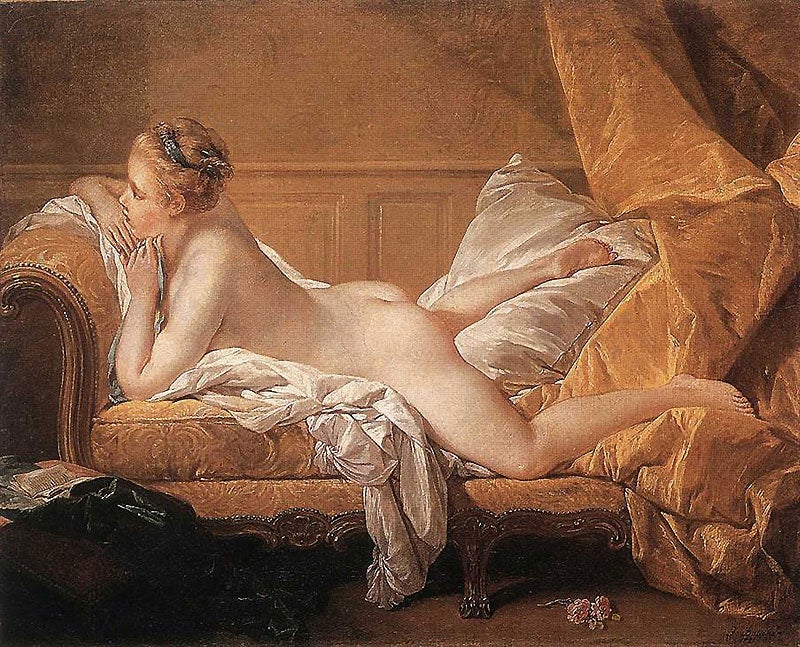Boucher, François: Mademoiselle O'Murphy (1751)
The Independent's Great Art series

The surrealist Georges Bataille said, "No collector could ever love a work of art as much as a fetishist loves a shoe." Was he right? Sexual arousal has always been part of painting's business.
Moralists have qualms. They try to draw lines – between art and pornography; or erotica and pornography. They ask: is the body being treated as a person, or as an object? Painting has a way of baffling such distinctions.
Boucher's Mademoiselle O'Murphy is one of the most sexually provocative pictures in the canon. Its subject, lying naked and splayed on a daybed, is Marie-Louise O'Murphy – a Parisian "child-courtesan", 14 at the time of painting, soon after to become the mistress of Louis XV.
Her age is perhaps why Boucher refrains from showing her frontally naked. But this notional decency only contributes to making her a more passive object. Beyond any seductive welcome, this body is simply ready.
The focus is on the buttocks. But that's not precisely where the provocation lies. This picture offers buttocks with wide-open legs – a direct invitation to penetrate.
But they're also where the painting gets most interesting. If you look at the contours of the two buttocks, the two legs and the pillow, you find an interplay of curves and tucks and creases and outlines and overlaps.
All that formal activity is designed to keep your eye on this spot. But it's also a kind of distraction. You now see the body in terms of the shapes it's making. You lose touch with its anatomy. At the sexual centre of the painting, pictorial interest and sexual interest are in conflict.
Boucher's priorities are divided. The pornographer in him may want to make a body that's helplessly available. But the painter can't help being excited by its potential as a composition. Each way the body is "objectified" – but in two different and diverging ways.
And when it comes to "objectifying", painting is always an unstable medium. It tends to blur the distinction between the animate and the inanimate. It treats living creatures like objects – and invests objects with life.
Look at the girl's right leg. The picture simply omits the thigh (which we understand to be bent up behind her), and leaves the lower leg lolling on the pillow, a bit of entirely lifeless flesh.
But then, look at the tumultuous bedding and the cascading curtain, which writhe and strain and press as if possessed by a muscular, anatomical life. The pillow pushes up between the girl's legs. There's an echo of mythological scenes where the god Jupiter impregnates a nymph in the form of a cloud or a shower of gold.
The art of painting, in other words, has its own compulsions. It's not very good at making proper moral distinctions between persons and things. The whole physical world tends to get mixed up, with life circulating though it promiscuously. But painting isn't very good at doing pure pornography either. Its sexual attention is always getting distracted.
And Mademoiselle O'Murphy, though it seems to have such an explicit purpose, will satisfy neither the moralist nor the lech. Like any true painting, if you love it, it has to be on its own terms.
The artist
François Boucher (1703-70) is the epitome of that art movement known as the Rococo – a fancy name for courtly fluff. He was a Parisian painter, and popular with Louis XV's chief mistress, Madame de Pompadour. His speciality was the enormous decorative scheme, filled with mythological confections. But if you look beyond the artifice (and the shadow of the guillotine), you can see Boucher as the prophet of French hedonism, which found its fulfilment in Impressionism.
Join our commenting forum
Join thought-provoking conversations, follow other Independent readers and see their replies
Comments